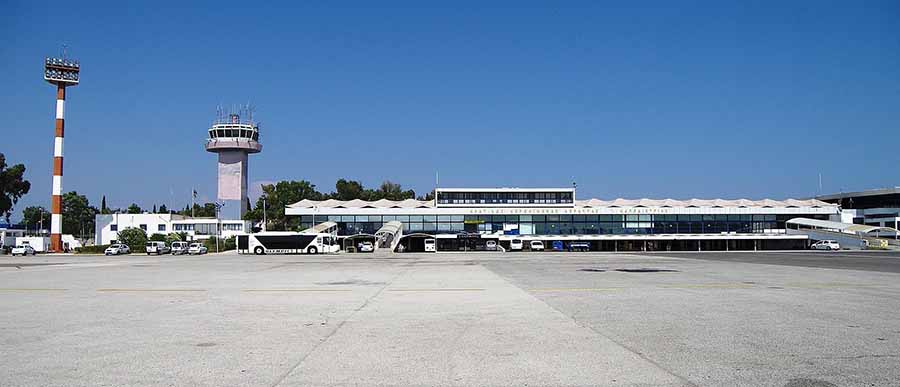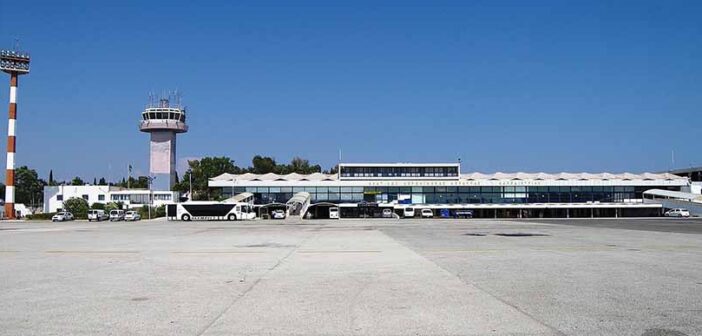
Corfu Ioannis Kapodistrias Airport, the gateway to the Ionian island of Corfu, offers a compact and welcoming experience for travellers exploring Greece’s emerald isle.
The passenger experience at Corfu, or CFU, is shaped by its small, modern terminal, handling around 3 million passengers annually across 100 destinations in 28 countries, primarily from April to October. Named after Ioannis Kapodistrias, Greece’s first governor, the airport serves as a hub for Ryanair and hosts Aegean Airlines, BA, and low-cost carriers like easyJet. The single terminal, with clear signage and a straightforward design, ensures easy navigation, though its modest size can feel crowded during peak summer months. The runway, surrounded by the Chalikiopoulos lagoon, offers scenic views of Pontikonisi and Vlacherna Monastery during takeoff and landing, adding a memorable touch to the journey.
Accessing the airport from Corfu Town, just 2 kilometres away, is quick and affordable. Bus route 15, operated by KTEL, connects the airport to the city centre and port in 10-15 minutes for £1.20, with services running every 30 minutes until 10 pm.
Taxis, available outside the arrivals hall, cost £10-£15 for a 10-minute ride, and pre-booked private transfers offer a queue-free option, especially during busy periods. Car rental desks from Avis, Hertz, and Sixt are located in arrivals, and a free car park with 270 spaces sits to the left of the terminal, though spaces fill quickly in summer. Driving via Georgaki Kostas Road is straightforward, with drop-off zones near departures.
The airport’s layout features a single terminal split into two sections: Terminal A for arrivals and Terminal B for departures, with check-in and gates on the ground and first floors, respectively. Ten check-in desks and five gates, some requiring bus transfers, keep operations simple but can lead to congestion during peak hours. The compact design minimises walking distances, though ongoing upgrades by Fraport Greece may cause temporary disruptions. Passengers connecting to international flights must re-clear security, which can add time.
Delays are infrequent but can occur during July and August due to high passenger volumes and limited terminal space. Weather, particularly summer storms, may affect schedules, and baggage handling can slow down, especially for international arrivals. Arriving two hours early for domestic flights and three for international is advisable, and checking airline apps for gate changes helps avoid surprises.
Dining options include Brava Cafe and Express Airport Restaurant in Terminal B, serving Greek dishes, sandwiches, and coffee, alongside fast-food outlets like Burger King and Starbucks. Most eateries close by 9 pm.
, with vending machines available for late-night snacks. Retail features a Hellenic Duty Free shop offering perfumes, alcohol, and Greek gourmet products, plus luxury brands like Swarovski and Michael Kors. A newsagent and souvenir shop cater to last-minute needs, and an electronic library via the Bookmate app provides access to over 800,000 books.
Facilities ensure comfort, with free Wi-Fi, though connectivity can be slow during peak times. Charging stations, ATMs, and a currency exchange desk are available, alongside a first aid spot and baby care facilities. Accessibility features include ramps, lifts, and wheelchair assistance, bookable 48 hours in advance. The Goldair Handling Lounge in the Extra Schengen Area offers snacks and drinks for a fee, while a smoking area outside the terminal serves connecting passengers, who must re-clear security. Nearby hotels like Hotel Bretagne, within walking distance, cater to layovers.
On-time performance is generally reliable, supported by the airport’s focus on seasonal routes, though summer congestion can lead to minor delays. Connections within the single terminal are straightforward, with Schengen-to-Schengen transfers taking under 30 minutes. Non-Schengen transfers involve customs and security, adding up to 45 minutes, so planning extra time is wise.
Corfu Ioannis Kapodistrias Airport blends efficiency with local flavour, offering a practical entry to one of Greece’s most beloved islands. Its proximity to Corfu Town and ongoing improvements make it a convenient hub for travellers seeking sun, sea, and history. Corfu Airport only has one terminal, making it quite easy for people to find their way, divided into three concourses (A-C), all adjacent to each other.
Aer Lingus
Aer Lingus operates seasonal flights to Dublin from the Main Terminal at Corfu International Airport. Check-in desks are typically in the Check-in Area (desks 1–15 range), but assignments vary due to the airport’s small size. Check-in opens 2 hours before departure and closes 45 minutes before departure. Online check-in is available 30 hours to 4.5 hours prior.
Departures are usually from Gates 1–10 in the non-Schengen area. Specific gates are assigned close to departure and displayed on airport screens. Corfu is a seasonal route (summer months), so confirm flight schedules and arrive 90 minutes before departure.




